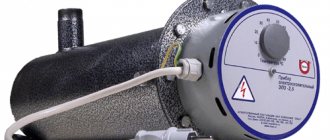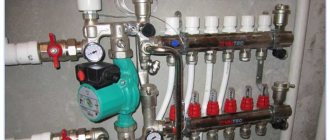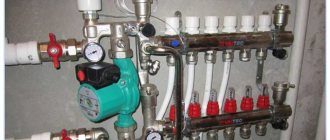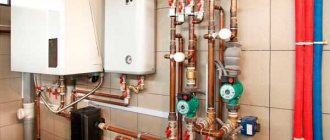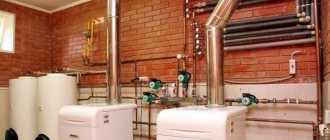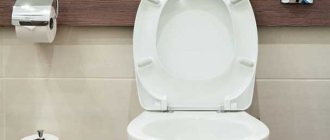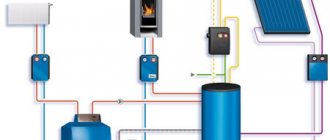Modern water heaters can be used as a reliable source of heating for small individually located residential buildings. A boiler with a high thermal power in the range of 7-12 kW will be quite capable of heating private housing construction up to 100 m2 or a cottage. This heat supply option has its advantages and disadvantages, however, it completely copes with this option.
The positive aspect of a heating boiler is that it can be installed by a home craftsman with his own hands, provided that all individual conditions for such a connection are met. An equally significant argument in favor of such a scheme is the availability of this type of heating at a price and a simple wiring diagram.
How to connect the device to the water supply network
The design of an electric or gas boiler provides for the selection of water for DHW needs from the upper zone of the tank, where it reaches its maximum temperature. Makeup from the cold water supply is carried out to the lower zone. This leads to the following problems with emptying the tank:
- draining is impossible from the “hot” side - the end of the tube is located too high, so literally 2 liters will flow out of the container;
- if you connect the pipe directly from the “cold” side, then to empty it you will have to unscrew the American pipe;
- draining water through the standard valve is inconvenient and time-consuming - the cross-section of the fitting is too small.
The presented boiler connection diagram solves the listed problems and allows you to empty the tank at any time, spending literally 15 minutes. Each element of the harness clearly performs its function:
- Ball valves on the main lines serve to isolate the water heater from the water supply and domestic hot water networks.
- A tee with a third ball valve on the “cold” side is designed to completely empty the tank.
- The safety (also known as non-return) valve discharges excess water, whose volume increases when heated. The second function is to prevent the tank from emptying back into the supply line.
- American ones allow you to disconnect the device without disassembling the system.
To correctly assemble the electrical boiler piping, it is enough to connect the pipes according to the diagram and attach them to the wall with clamps. Lastly, the American ones are screwed on, and a flexible hose is put on the “spout” of the safety valve and directed into the sewer. The installation process of a storage water heater is clearly demonstrated in the video:
After assembly, check the tightness of the joints by opening the cold water supply. Filling the tank is done with the “hot” mixer tap open to release air. After making sure the connections are secure, proceed to electrical installation.
General positive aspects
Generally speaking, all electric boilers, regardless of type, have a number of advantages:
- ease of execution;
- there is no need to separately create a place for installing equipment;
- no need to think about purchasing, delivering and storing energy;
- there is no need to remove the chimney;
- safety, because there is no possibility of leakage of toxic substances;
- environmental friendliness - no harmful emissions.
If you install electric double-circuit water heating units, connecting all its functions, the consumer will not experience any problems with heating the room or supplying water at the required temperature for household needs.
Connecting an indirect heating boiler
The unit is a tank with a built-in coil that heats the main volume of water. Accordingly, the heat exchanger is connected to the boiler, and the tank is connected to the hot water supply system. The same safety valve is used to drain excess water that expands when heated.
The easiest way is to connect an indirect heating boiler to a single-circuit boiler equipped with special pipes. Inside the heat generator there is a three-way switching valve that distributes the coolant flow for heating or loading the hot water boiler - as the electronic control unit orders. In this case, the heater coil is simply connected to the corresponding pipes.
A typical diagram for connecting a water heater to a heat source includes the following elements:
- a separate circulation pump driving the coolant through the boiler coil;
- immersion thermostat that turns off the pump when the water is heated to the set temperature;
- 2 check valves that prevent the formation of parasitic flows through the heating and hot water circuits;
- hot water tank safety group;
- shut-off valves.
The operation of the pumping unit is controlled by a thermostat built into the boiler (it has a special socket). When water withdrawal begins, the container cools down and the thermoelement starts the pump; when it is heated sufficiently, it stops.
Photos in the text to illustrate what was said
Storage tank and electric boiler
Installation of an electric boiler in a heating circuit
Boiler Ariston ABS PRO R 150 V
Water heater model Thermex Champion Titaniumheat 150 V
Types of electric boilers for heating systems
Indirect heating boiler
Determining the efficiency of a new water heater
How to start using your new boiler economically and correctly? Experts focus on determining its energy efficiency when purchasing.
General rules
Before purchasing equipment, the user needs:
- compare the energy efficiency of expensive and budget models in the store to establish the return on investment of the equipment;
- clarify that the energy efficiency class includes efficiency, losses per hour during heating and maintaining temperature, circulation. Information is indicated in the manufacturer's booklet;
- take into account the displacement of the container, the operating speed of the heating element, the type of installation to clarify the total costs.
Interesting to know! On European boiler models, energy efficiency has been indicated since 2013, on American ones - since 2009.
Calculation of annual operating costs
For calculations, you will need information about the energy efficiency class, type and cost of the coolant. Further calculations are performed using the formula:
- for gas models, the number of days per year is multiplied by energy efficiency and the cost of a cubic meter of gas;
- for electric boilers, the number of days per year is multiplied by energy efficiency and the cost of kW/hour.
Interesting to know! The DOE test for water heaters takes into account cold (15 degrees) and hot (60 degrees) temperatures and determines the unit's performance for a family of 3 as 240 liters per day.
Heating element power as a saving factor
The greater the power of the heating element, the faster the water will heat up. Keep in mind that in houses with a single-phase wiring diagram, from 7 to 10 kW of power are allocated. A high-performance water heater will lead to increased load on the network, huge energy costs and tripping of circuit breakers.
Classification
Electric boilers are divided into three main types:
- heating elements;
- electrode;
- induction
In addition, there are a number of other differences between them. For example, there are floor or wall models. They can be connected to 380V or 220V - depending on the size of the room (used for a private house or small apartment). Also the main indicator is the number of circuits in which hot water is located - one or two.
heating elements new
An electric boiler operates based on the process of converting current into thermal energy through the use of tubular heaters installed directly in the tank. The heating element raises the temperature of the liquid inside the pipe. When it enters the heating system, it warms up the room.
To ensure that the device always works as required, a control unit is provided. The heating is controlled by a room temperature controller. It is he who perceives a decrease in this indicator and reports the need to increase heating. The required pressure appears as a result of connecting the pump. Thanks to the use of modern technologies, after the room temperature rises to the set point, the mode is turned off. After some time, the pump that moves the coolant also stops working.
The main advantage of this type of boiler is the absence of contact between the liquid and the heat exchanger. This allows the use of protective devices for automatic shutdown.
The equipment makes it possible to simply implement smooth or step control.
Like any other devices, these have their drawbacks. Heating element boilers have a limited service life compared to other boilers. Premature burnout due to improper use cannot be ruled out. Before purchasing, be sure to pay attention to the possibility of repair or replacement.
Also, scale quickly forms on the tubular heater itself. This significantly reduces the service life of the device. It is imperative to artificially reduce the hardness of the liquid.
Such water heating boilers are single- and double-circuit units. The latter provide hot water supply and heating.
In most cases, installations are hung on the wall, although there are also those that are located on a flat, hard surface.
This type is considered the most popular among electric boilers.
Electrode
Heating of the coolant is carried out by direct passage of current through it. In this case, there are no “intermediaries” in the form of heating elements. Electrolysis does not occur since the anode and cathode are constantly changing places.
It is important to note that if operated without liquid, the electric heating or hot water boiler will not fail. In addition, scale does not destroy the electrodes - sometimes a slight decrease in power is observed.
The coolant temperature increases quickly. This increases the pressure with which water moves through the network - there is no need to install a pump. Perfect for the bathroom as it doesn't take up much space.
We recommend: What is a bithermal heat exchanger and its pros and cons
Such a water unit has an efficiency of about 96%. At the same time, it is durable and reliable in use.
Such a device cannot be connected through a protection element. Only special antifreeze is used as a coolant.
Induction
Such installations have a design similar to a transformer consisting of two circuits. The primary is the magnetic system, and the secondary is the heat exchange device. By means of an alternating field, electricity allows the coolant to be heated.
The main advantages include safety, as well as interaction with various heating fluids. Like the previous option, it is well suited for the bathroom.
But there are also disadvantages. The main ones are the initial price, as well as the cost of subsequent operation.
Boilers
It is worth mentioning electrical storage installations. In fact, they are heating elements equipment installed in parallel. In this case, they can be intended either separately for hot water supply or heating, or for both directions. For the latter, indirect heating systems are used. Such storage electrical installations make it possible to raise the temperature of water for household needs with coolant intended for heating.
This boiler is ideal for use in country houses. It is mainly installed together with boilers that use any energy source. At the same time, it is barely warm on the outside, since usually such installations have high-quality protection that allows energy to be stored inside for a long time.
Connection to the house electrical network
The power of the vast majority of water heaters does not exceed 3.5 kW. If the consumption of your household appliance is within the specified limits, feel free to connect the boiler through a standard socket equipped with a grounding contact (required!). The work is simple: run a three-core cable from the distribution box using a corrugated cable or plastic box, and place a socket next to the heater.
Exposed wiring and outlet knobs are not popular with all homeowners. To make the electrical connection to the water heater more efficient, follow our instructions:
- Lay the cable in a hidden way - in the grooves of the walls or under plasterboard sheathing, connecting it to the nearest electrical outlet box or directly to the electrical panel.
- Install a two-pole 20 A circuit breaker in a convenient place, placing it in a decorative plastic box.
- Using the clamps, connect the cable to the machine.
- After unscrewing the fastening screws, remove the cover from the bottom of the boiler. There is a connector hidden under it where you need to connect the wires. Do not forget about the grounding contact - it must be connected to the appropriate bus.
Plug in the boiler filled with water and check its functionality. Since on budget versions of the devices the heating temperature is regulated directly on the heating element, do not rush to put on the lid. Wait until the water reaches a comfortable temperature (look at the indicator) and turn the adjusting lever at the end of the heating element so that the heating element turns off.
The nuances of choosing the right model
Electricity is an expensive energy resource. If the boiler is selected incorrectly, you will have to pay huge electricity bills.
Therefore, it makes sense to pay attention to some nuances:
- functions . It is necessary to decide what functions the boiler should perform - only heat the house or additionally supply it with hot water.
- Technical parameters of the boiler. Be sure to take into account not only the heated area, but also the degree of its thermal insulation.
- Price . In many ways, the cost of heating devices depends on power, but that’s not all. Additional features can lead to a significant increase in the price of the model. Therefore, you need to clearly understand whether your budget allows you to overpay for convenience.
Even before you start looking for a boiler, you should find out how powerful it should be.
You can calculate the power based on average indicators: 1 kW of electricity is enough to heat a room of 10 square meters. with a ceiling height of up to 3 m. It turns out that a device with a power of 6 kW or more is suitable for heating a small house with an area of 60 m2.
When purchasing an electric boiler, energy consumption is of fundamental importance. It’s better to overpay for a more expensive model, but save on its operation
It is advisable to take into account the degree of thermal insulation and buy a boiler with a small power reserve (20%). If the house is poorly insulated, it is better to choose a gas or solid fuel model, since heating with electricity will be too expensive.
Installation of a boiler for heating
Installation of a heat supply circuit using a water heater as a heating source is performed as follows:
- Select a location and prepare it for installing the water heater. The site must have a flat horizontal surface measuring at least 1x1 m.
- The foundation for structures with a volume of more than 200 liters is made of concrete, reinforced with reinforcement.
- The water heater structure is installed in a strictly vertical position.
- I am installing an electric circulation pump.
- Perform pipe piping. The outlet of the water heater for heating is connected to the electric pump, and the input is connected to the return line.
- Shut-off and control equipment and security system monitoring sensors are installed.
- The device is connected to the power supply through a separate panel with a machine and an RCD.
- After assembling the circuit, perform hydraulic pressure testing of the heating system and check the functionality of the electrical heating circuit of the heating element.
Boiler for electric heating - service instructions
Servicing electric boilers in heat supply systems is no different from performing the required operations for servicing a heating element device. The heating boiler will work well if you adhere to the following rules:
- Monitor the integrity of the installation’s thermal insulation monthly.
- Observe the temperature difference of the coolant; it should not exceed 15-20 C.
- Monitor the tightness of pipe connections for leaks.
- Every year before the heating season, perform system maintenance by flushing the internal circuit and replacing gaskets.
- They monitor the operating parameters of the electrical network; if there are frequent failures in the electrical lines, you need to install a stabilizer to preserve the electronic control unit.
To select the heating power from the boiler, the calculation is 1 kW per 10 m2 of heated room. This formula is well applicable in systems located in the central climatic region of Russia. Next, you will need to decide on the minimum tank volume. Provided that the minimum level of storage capacity is 5 kW and the temperature difference between forward and return water is -20 C, the volume of the tank will be:
V=5/20=0.25 m3 or 250 l
Advantages and disadvantages
The main advantage of boilers for heating a home is the simplicity of the system and low cost. To install boiler heating, no special equipment is required, and installation can be done independently.
The main disadvantage of boilers is their low power. Conventional household appliances are capable of heating only small houses and cottages, and even in moderate frost outside. In addition, heating elements must operate continuously in the cold season, which leads to their frequent failure. The heaters themselves have a low price, but repairs are quite labor-intensive, which stops the heating system for a long time.
Connecting an indirect heating boiler to a single-circuit boiler - diagram
According to the diagram, you need to find the terminals for the boiler sensor in the boiler and connect the ends of the wires to them.
Conventional indirect heating boilers work mainly with automated boilers.
Connecting the boiler to the boiler using a three-way valve This connection diagram is perfect for gas boilers equipped with a circulation pump and automation. Preference is given to wall-mounted models that can be hung at a height of 1 m above the floor.
The best position is when the bottom of the hot water tank is higher than the heating boiler and radiators. How to properly connect an indirect heating boiler to a heating system? They are less often connected to free-standing boilers of similar volume.
Indirect heating boiler design
Indirect heating These water heaters do not produce thermal energy themselves. If you need to create a connection diagram for a solid fuel boiler that runs on wood, we recommend choosing the option shown in the picture below. Some manufacturers deliberately produce equipment with standard dimensions of connectors and fittings.
In this scheme there is no three-way valve; the circuit is connected through ordinary tees. With this part, the unit lasts much longer. Operating at very high temperatures can cause premature damage to the inside of the tank. Types of double-circuit gas boilers with a built-in boiler, are they needed? Boilers are used in conjunction with single- and double-circuit gas boilers. The circulation pump is common here; it circulates the coolant through the heating circuit and through the water heater.
How to connect an indirect heating boiler (water heater)
Scheme for connecting an indirect heating water heater to a gravity system When implementing this scheme, the circuit that goes to the water heater is made into a pipe with a diameter 1 step larger than the heating one. They have a coil and a built-in heating element.
This piping method is useful for those who use the boiler in constant mode 2: Option with two circulation pumps If the boiler is used rarely, for example, seasonally or on weekends, or there is a need for water whose temperature is lower than in the heating system, use a scheme with two circulation pumps . The heating system of an apartment or house is working, and the water in the boiler is heating up as if in passing as a side effect. A boiler connected to heating equipment and electric heating elements. This method is only possible if you have separate boiler equipment that can operate from natural heating sources in the form of liquefied gas, coal or firewood all year round. The hot water supply circuit also has higher priority over the heating circuit, but this is achieved only by adjusting the switching algorithm. Performing piping requires preliminary competent thermal calculations. Ufa. Connection diagram for an indirect heating boiler.
Specifications
A boiler for heating a private house, which is supposed to be included in the heating circuit, must operate in the temperature range of 60-70 C and have low thermal inertia of the system. The latter characteristic directly depends on the type of heat exchanger and the electrical power of the heating element. In containers up to 250 liters, heating is achieved in 1.5 – 2.5 hours. In addition, such water heating devices must operate from a 220 V household power supply, with a load not exceeding 30 - 40 A, so that a home craftsman can connect the device independently, without requiring special permission from the distribution zone.
Standard structural structure of a domestic water heater:
- A housing that protects functional elements from external interference.
- A storage tank located in the middle of the structure, isolated from it by a heat insulator. The best volume for autonomous heating is considered to be devices from 150 to 300 liters.
- The heating element is a heating element. It can be made in a variety of design forms: rod, spiral and round.
- An essential characteristic for such boilers is thermal power. It should be from 7 to 12 kW, which will allow heating a room up to 120 m2.
- Inlet/outlet pipes on the boiler for heating. The heating performance is determined by the rate of heat transfer, which depends on the diameter of the outlet pipes. In DHW boilers they usually have a cross-section of up to 20 mm, and for the heating function they need at least 32 mm. In this case, the larger the diameter, the more efficient the heating system functions. Of course, provided that the thermal power of the heating element is sufficient.
- Controlling primary temperature sensors of the coolant, integrated into the operation circuit of the circulation pump.
- Relay for monitoring the operation of the electrical network in order to protect the device from possible long-term overloads.
How to make a harness without errors?
In order for both units - both the gas boiler and the BKN - to operate without failure and throughout their entire service life, it is important to properly perform the piping, that is, install the safety group and other elements. When installing coarse filters, be sure to check its location - there is an arrow on the body indicating the direction of water movement
When installing coarse filters, be sure to check its location - there is an arrow on the body indicating the direction of water movement.
Such a filter cannot be installed vertically, since as a result, coarse particles accumulate in the pipe and not in the filter itself. Cleaning can only be done by pressure washing - this way you can dirty the entire boiler room.
The expansion tank must not be installed separately, but between the boiler and the check valve, otherwise it will be useless and will not perform its functions.
The most economical electric boiler is a myth
Electricity is much easier to convert into heat than other energy sources - natural gas, solid fuel, diesel fuel. Here are 3 simple examples of heat by-products when using electricity:
- the windings of any operating electric motor always heat up;
- a light bulb (even an LED one) produces heat along with the light;
- Even the wires through which current flows become heated.
Please note that the equipment listed is designed to perform its functions, and not to heat the house. The motor rotates something, the lamp shines, the wiring supplies them with energy. The formation of excess heat is a side effect that occurs due to the resistance of these elements.
Spiral and induction heater converting electricity into heat with 99% efficiency
To convert all electrical energy into thermal energy, it is enough to create a high resistance section in the circuit, which itself will not collapse from heating. This element is called an electric heater. The second (more complex) way to obtain heat is to create Foucault induction eddy currents that heat a metal object in the area of action of the inductor coil.
Important point. Regardless of the conversion method, 98–99% of electricity will turn into heat. That is, any electric heating device operates with an efficiency of 98–99%, no less. This means that the most economical electric boiler does not exist; all units are equally efficient. No matter what home appliance sellers claim.
Distinctive features of an indirect heating boiler
A boiler is a large barrel whose main function is storage. It comes in different volumes and shapes, but its purpose does not change. Without a boiler, a problem may arise when using, for example, two showers or a shower and a kitchen tap at once.
If a household 2-circuit boiler with a power of 24-28 kW produces only 12-13 l/min per flow, and one shower requires 15-17 l/min, then when any additional tap is turned on, there will be a shortage of water supply. The boiler simply does not have enough working capacity to provide hot water to several points.
If a large storage tank is installed in the house, even with several water points turned on at the same time, everyone will be provided with hot water
All storage boilers can be divided into 2 large categories:
- direct heating, creating a supply of hot water using a heating element - for example, an electric heating element;
- indirect heating, heating water with already hot coolant.
There are other types of boilers - for example, conventional storage water heaters. But only volumetric storage devices can indirectly receive energy and heat water.
BKN, unlike energy-dependent equipment running on electric, gas or solid fuel, uses the heat generated by the boiler. Simply put, it does not require additional energy to function.
BKN design. Inside the tank there is a coil - a steel, brass or copper tubular heat exchanger that acts as a heating element. Heat inside the tank is retained according to the principle of a thermos
The storage device fits easily into the DHW system and does not cause problems during operation.
Users see many advantages in using BKN:
- the unit does not require electrical power and benefits from the economic side;
- hot water is always “ready”, there is no need to let cold water pass through and wait for it to heat up;
- Several water distribution points can operate freely;
- stable water temperature that does not drop during consumption.
There are also disadvantages: the high cost of the unit and additional space in the boiler room.
The volume of the storage tank is chosen based on the number of people permanently residing in the house. The smallest boilers are designed for 2 consumers, so when choosing, you can start from a volume of 50 liters
According to all characteristics, the BKN is suitable for use in conjunction with a gas boiler. Moreover, this is one of the best solutions for equipping a hot water preparation system for a private house with a large number of residents.
But boilers are different, so we will consider both acceptable options and those where problems may arise.
Features of the electric boiler
The main design elements of an electric heating boiler are a tank and a heating element. The devices are equipped with monitoring and automatic control systems.
Various models may also include expansion tanks and circulation pumps.
When purchasing a boiler, you should pay attention to the type of electric heating element. Over time, lime particles settle on the heating elements, which affects the power of the device
Electric boilers have several advantages:
- Fire safety . Thanks to automatic control systems and the absence of open flames, the devices are safe. They do not emit toxic substances or combustion products and are not capable of exploding.
- Ease of installation. Electrical equipment requires no flue or ventilation, making installation easy.
- High efficiency . Regardless of the type of heating device, all electric boilers are highly efficient.
- Compactness . Electrical appliances, especially wall-mounted ones, take up little space.
- Nice design . Most modern models are stylistically versatile and look good in the interior.
Electric boilers are almost ideal - easy to use and safe. Their only serious drawback is the high cost of electricity. One more nuance: for residents of regions where there are frequent interruptions in the power grid, it is better to choose boilers that operate from other energy sources, or take care of purchasing additional heating devices.
How does an electric water heater for heating work?
As a rule, such devices are used exclusively for hot water supply. But modern technologies make it possible to use it as an additional thermal circuit for heating water in a heating system. Before using the water heater to prepare the coolant for heating devices, it is necessary to modernize its recharge circuit:
Create a forced coolant circulation circuit.
It is necessary to connect the heating circuit with the installation of protection and control devices: an expansion tank, a circulation pump and shut-off and control valves, a control and protection unit with primary sensors for temperature and pressure of the medium.
The originality of the idea, and its practical implementation, lies in the synchronous operation of the same source: for hot water supply and heating. For this reason, it is recommended to first select an electric pump of the required electrical power. It must be able to cover all hydraulic losses in the system and evenly distribute heat throughout the heating devices. Experts recommend installing water purification filters at the inlet in front of the boiler in simultaneous hot water and heating systems.
Storage tank and heating boiler
The storage tank is ultimately completely identical to a classic water heater. The difference lies in the internal coil, which is connected to the heating system.
A professionally organized heat supply system through a heat exchanger implies that this component will act as a thermal accumulator. The liquid medium in the tank receives heat through a coil heat exchanger connected to the in-house heating pipe system.
Indirect heating boiler
The optimal alternative for heating small rooms is to include an indirect heating boiler in the heat supply scheme. They can be universal, capable of operating on different types of energy carriers: gas, flue gases from the combustion of solid fuels and electricity.
Typically, such devices are installed in heat supply circuits to increase overall efficiency in the form of an additional heating source. The main one is the traditional heating boiler. For efficient operation of an indirect heating water heater, it must be installed before entering return network water into the boiler unit. In this way it is possible to create an optimal heating system.
Do-it-yourself electric boiler for the heating system
The price of industrial modifications of heating water heaters is very high - from 12,000 to 70,000 rubles. and higher. Therefore, their alternative can be a heater made in-house. For this case, it is allowed to use an arbitrary steel tank of increased strength, with parameters corresponding to the design ones.
To wire the heating circuits of a homemade water heater, you will need the following parts:
- Tank. It would be preferable to place an order from a specialized organization for a device made of non-corrosive steel or assemble it yourself. It is necessary to place holes on the body in order to solder the inlet/outlet pipes.
- Coil heating element, the best choice is copper. This metal has the best heat transfer coefficient and temperature elasticity.
- Fastening elements for piping heating and hot water systems.
- Automatic safety with primary sensors and protective devices in the form of an air vent and an expansion tank. The kit is purchased in a retail chain according to the parameters of the working tank.
- Thermal protection of the boiler from loss of thermal energy. To do this, a glass wool/basalt heat insulator of at least 5 cm is placed in the layer between the tank and the protective casing.
The principle of operation of a boiler with two circuits
From the name it is clear that such a device has all two circuits. The first circuit is intended for heating. The second is to provide hot water. The operating principle of a double-circuit boiler is simple. The default is to use the first circuit. No heat enters the second circuit. A special valve is used for this. When the hot water turns on, the valve prevents heat from entering the heating system. Instead, it enters the second circuit and heats the water. When the water turns off, only the heating works again. That is, hot water is used on demand and the rest of the time there is no excess gas consumption
